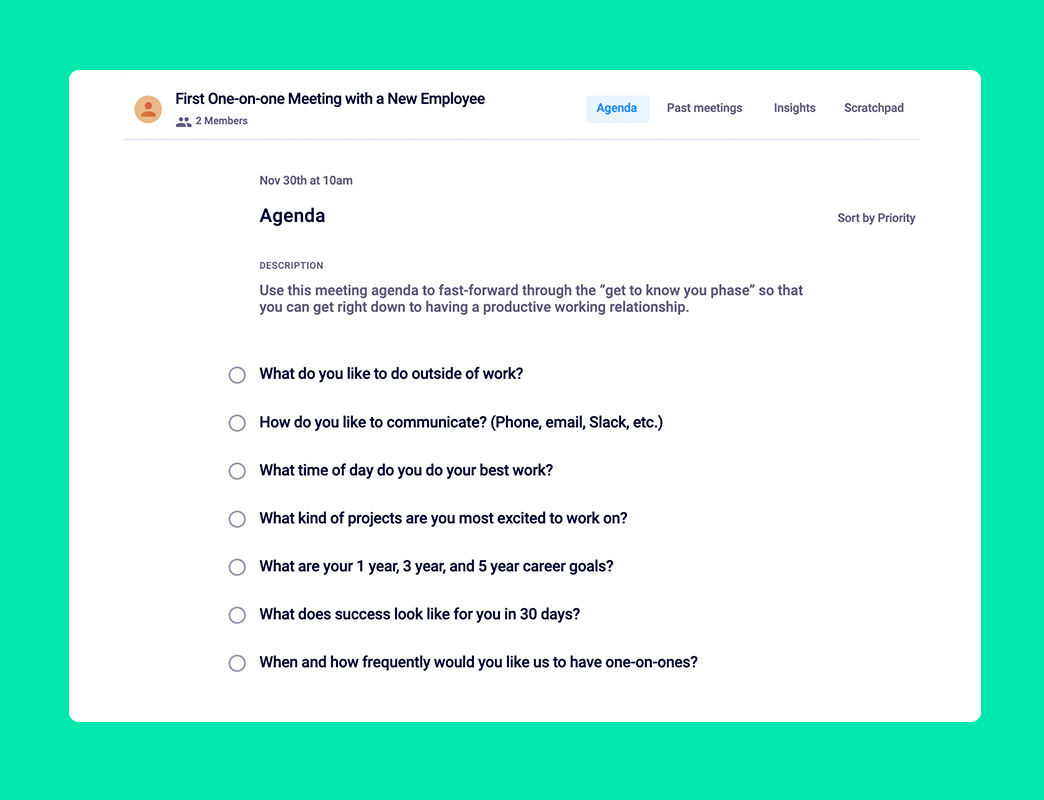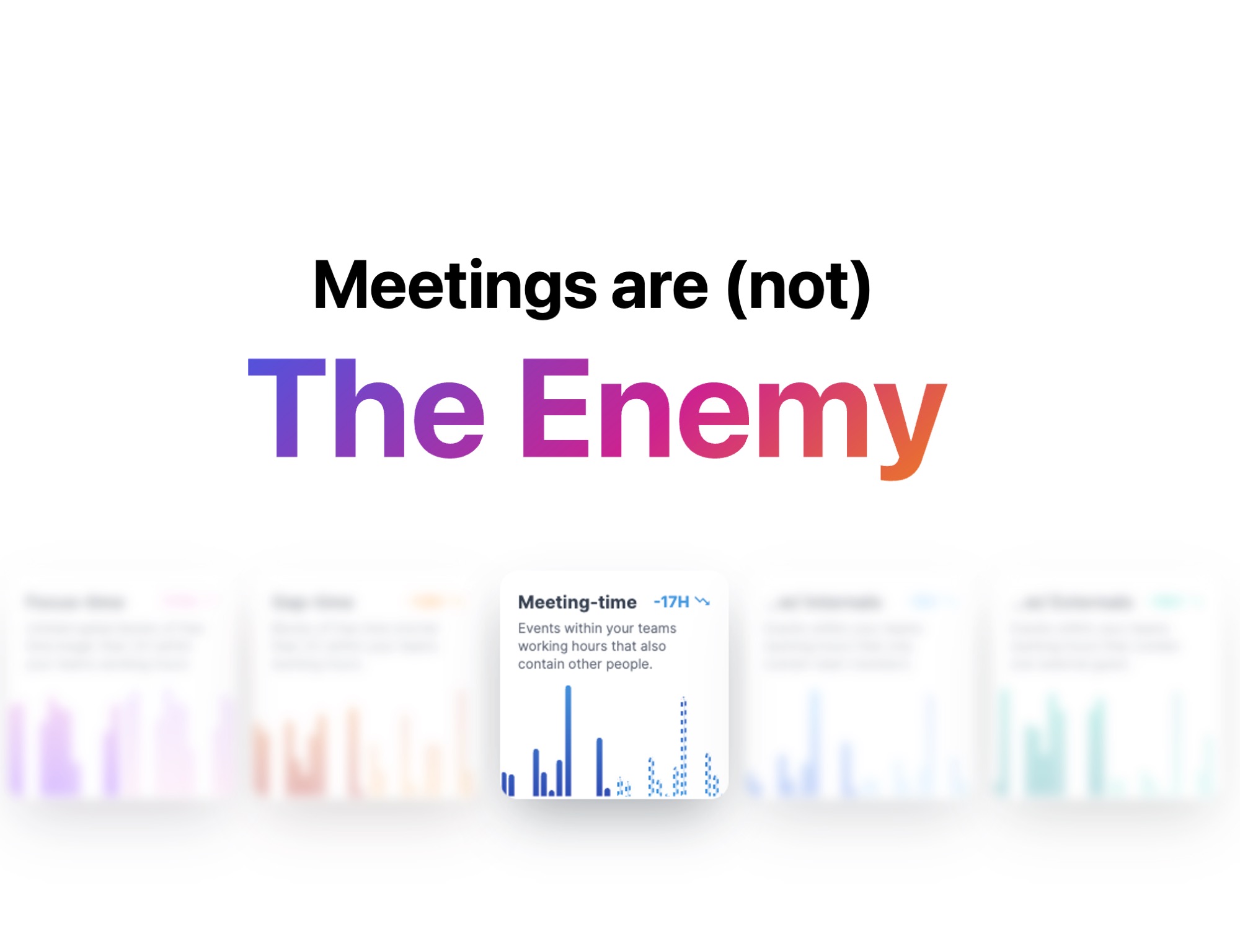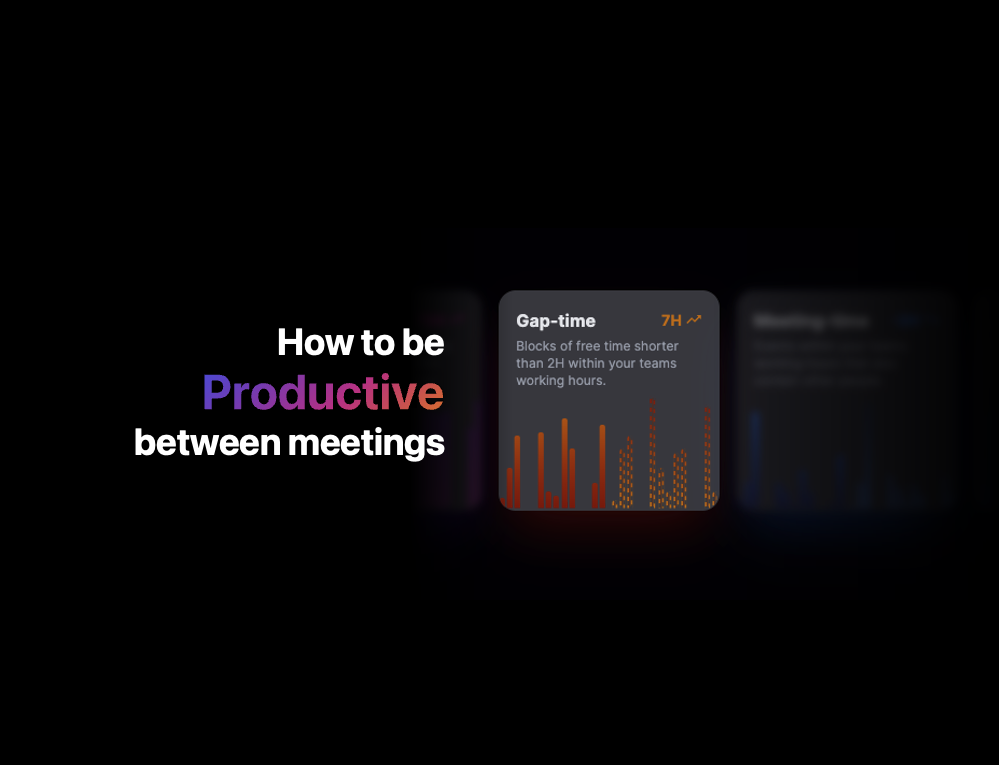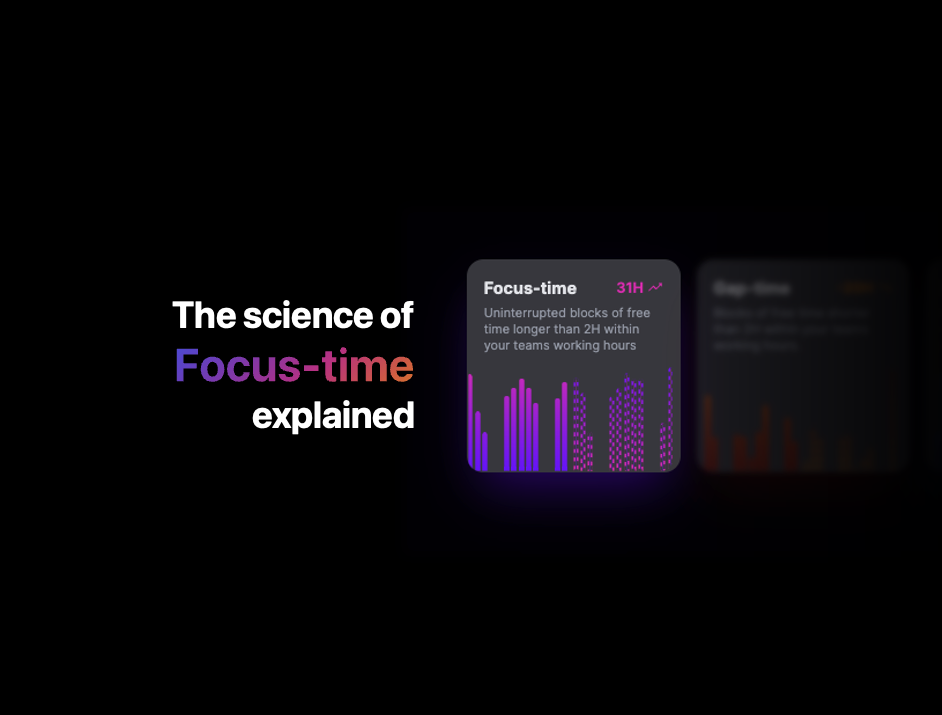7 Questions to ask in your first one-on-one with a new employee
10 min readYour first one-on-one meeting is a chance to set the tone for how you'll work with your new employee. This article reviews everything you need to know before your first 1:1. (Plus, an agenda template to get you started!)

The first days at a new company can be exhilarating and overwhelming at the same time. There are laptops to set up, new processes to learn, teammates to meet — the list goes on. As a manager, you play a large role in how those first few weeks go for your new employee.
One critical item that every leader should have on their onboarding checklist is setting up the first one-on-one meeting. It’s your chance to make a positive first impression and set the tone for how you’lll work together moving forward.
In this post, we’ll go through:
- Why your first one-on-one meeting matters
- How to set up your first one-on-one meeting with a new employee
- 7 questions to ask your new hire in your first one-on-one
- Hypercontext’s agenda template for your first one-on-one meeting
Why does your first one-on-one matter?
Hiring is a whirlwind. There’s the lengthy interview process, the offer, preparing for their arrival— phew! But now that they’ve started, where do you begin?
Your first one-on-one is like your first impression. It’s the first opportunity to make your new employee feel welcome, connected and create a sense of belonging in your company.
What’s more, it’s a time to set the tone and expectations for future one-on-ones. Amalia Fowler, Creator of Wholehearted Manager Newsletter, explains:
“This is your opportunity to set expectations and the tone for literally every future 1:1 (no pressure)! Send an agenda and some questions in advance so they can have time to think and understand what is expected of them in the meeting, and keep it very ‘them’ focused.”
– Amalia Fowler, Wholehearted Manager
How to set up your first one-on-one meeting with a new employee
When setting up your first one-on-one meeting, don’t just send an invite and leave it at that. Throwing a meeting in your new hire’s calendar with no context could make them nervous. And let’s face it, starting a new job is nerve-wracking enough! Before you send out that calendar invite, here’s what you need to do to set up your first one-on-one meeting:
📒 Create an agenda
Agendas are like rudders for meetings — they don’t dictate where you’re headed, but they help you navigate your way there. Before your first one-on-one, create an agenda to guide your conversation and make sure you cover what you need to. Jordan Choo, Managing Partner at Kogneta, explains:
“Come prepared and share the list of questions and topics that you want to go over in advance. This helps ensure no one is caught off guard and the meeting can be productive. It’ll help create a ‘you and them vs. the problem’ mentality, rather than a ‘you vs. them’ one.”
– Jordan Choo, Kogneta
Moving forward, your employee will likely own the agenda for your one-on-ones, but you’ll take the reigns on this one. That being said, make sure you still encourage input and, like Jordan said, share it in advance.
👉 Skip to the Hypercontext agenda temlpate now
🤝 Set expectations
This might be your new employee’s first one-on-one meeting. So setting expectations for what you want to get out of it — and what they should plan for — can help get the meeting off to the right start. It’s helpful to include the purpose of the meeting in your agenda, so that your employee has an understanding of what they’re walking into before your first meeting.
Vinay Vishnumurthy Adiga, Manager, Software Engineering at Jobber, expands on why it’s important to set expectations in your first one-on-one:
“The goal of the first 1:1 meeting should be getting to know each other while establishing a stage for future meetings. It’s recommended for managers to utilize the first meeting to not only understand more about the new employee’s life, FUDs (if any), career aspirations and their immediate goals; but also to open up about themselves and their expectations for the new employee. There’s no playbook for this, however being respectful of one another is very important. This helps the employee to not only learn more about you but also structure themselves better for a productive conversation.”
– Vinay Vishnumurthy Adiga, Jobber
🪴 Choose an appropriate location
It’s important to choose a location that feels safe and private for your 1:1s. Don’t hold them in the company kitchen or lounge area. Book a meeting room ahead of time that would be a safe space for sensitive discussions. While you may not be covering anything too sensitive in your very first one-on-one, you surely will down the line. Set the stage.
For remote one-on-ones, it’s a bit easier as video chat automatically provides a more private space to talk. But, make sure you’re taking the call from somewhere without too many people around. If there is someone around, let your direct report know that. The last thing you want is for them to share something vulnerable only to be surprised that someone else could hear the conversation. That’s a sure-fire way to break trust.
🔍 Remove distractions
It’s important to give your new employee your undivided attention. Put Slack on do not disturb, turn your phone over, resist checking emails. Make sure you’re actively listening to your new employee. When it comes to taking notes, it’s definitely best practice. But don’t let this come at the expense of truly listening — especially in your very first 1:1. If you are taking notes, let your direct report know that’s what you’re doing so they can feel confident you’re hearing them.
7 Questions to ask your new hire in your first one-on-one
Now that you’ve got your first one-on-one scheduled with your new employee, it’s time to take a look at some questions you can ask for a meaningful discussion.
🤫 Psst: We’ve got 121 more questions where those came from.
1. What do you like to do outside of work?
Learning about your new employee’s hobbies, sports, or other activities is a great way to find common interests, form bonds, and build trust.
Work is just part of our lives — finding out more about what motivates your new employee can potentially give you ideas for everything from motivation to future team building activities (Bowling, anyone?)
Fabian Camargo, Management Coach at Camargo Consulting, explains that he likes to start off the meeting with more personal questions to get across these messages:
- I’m interested in getting to know them as a person
- I’m willing to be vulnerable and open up about myself
- I want to respect their boundaries
- This meeting isn’t all about work
- This meeting isn’t super formal
2. How do you like to communicate?
In the old days (the 90s), you phoned someone to get a hold of them. In the less old days (the 00s), you could call or email. Today, we’ve got texting, Slack, Zoom, phone, email, Teams, WhatsApps, Signal, and more to choose from.
Whether you’re in an office, remote or hybrid workplace, you’ll find that everyone has a preferred method to communicate. Your first one-on-one is the time to figure out what works best for you and your new employee. We’ve set up a hierarchy of what channels we use for how important something is and what can be done asynchronously versus what needs to be done in real-time:
✉️ Email – it can wait a day or two
💬 Slack – sometime today, but not major unless noted
📞 Phone – we need you right away!
But beyond the actual method of communication itself, it’s also important to understand communication styles. Jordan Choo presents an example of why your first 1:1 is an important time to get a grasp on your team member’s communication style:
“ I speak very directly while some team members speak indirectly. As a result this can cause rifts in how ideas, recommendations and feedback is given and interpreted. By nipping the potential issue in the bud immediately, you’re able to stay aligned a lot better throughout the onboarding process and after it.”
– Jordan Choo, Kogneta
3. What time of day do you do your best work?
We’re not all morning people — even with copious amounts of coffee. Use your first one-on-one to learn about how and when your employee works best. Some people get their best work done late at night. Others are power workers right after a nutritious breakfast.
This is a great question to find out when your employee needs focus time too. Setting expectations for when you need them to respond can help them block time to get work done.
4. What kind of projects are you most excited to work on?
Your one-on-one is a chance to find out what projects inspire creativity and energy in your new employees. Use this question to find out what motivates them — and what types of projects they might need help on. It’s a great way to set them up for success with tasks and projects that they’re jazzed about.
5. What are your 1-year, 3-year, and 5-year career goals?
Understanding your new employee’s desired career path provides you with opportunities to help them set milestones. For example, if they’re interested in advancing as a leader, you might find ways for them to exercise leadership skills.
John Thomas Lang, Director of Marketing at ChargeAfter, explains:
“I always want to find out early how I/the company can help them in their career goals short and long-term. If they don’t have an immediate answer, I like to ask questions like: what areas of advancement are you hoping for here? Is there anything that’s not in your ‘job description’ that you want to learn? What excites you outside of work? This should help you find some stretch goal areas to focus on.”
– John Thomas Lang, ChargeAfter
Remember, this is just the beginning of an ongoing conversation.
6. What does success look like for you in 30 days?
Understanding what success looks like for your new employee can help you create a plan for the first month as they try to find their place in the company. Decide on 2 or 3 milestones your employee could realistically accomplish in their first 30 days. These milestones could be a first project or simply setting up meetings with people on other teams (especially in larger organizations).
This is also a great time to learn more about where their anxieties lie and how you can mitigate them so they’re set up for success from the very start. Meg Murphy, Manager of Product Marketing at Visual Lease, explains:
“Everyone has first week jitters, and they’ll show up in different ways. In the first 1:1, it’s about making sure folks feel confident working through them.”
– Meg Murphy, Visual Lease
7. When and how frequently would you like to have one-on-ones?
The only thing worse than a poorly planned one-on-one is skipping them altogether. If you or your new team member start canceling at the last minute, it could be a sign to the other person that the meetings aren’t valuable. Plan out a schedule that works for both of you and stick with it.
More resources: For your future one-on-ones, check out these helpful articles to make the most of your time together:
✨ One-on-one meeting templates
✨ Tips for effective one-on-one meetings
✨ One-on-one meeting guide
First one-on-one meeting with a new employee agenda template
To get off on the right foot with your new hire, try this first one-on-one meeting agenda template. 👇



